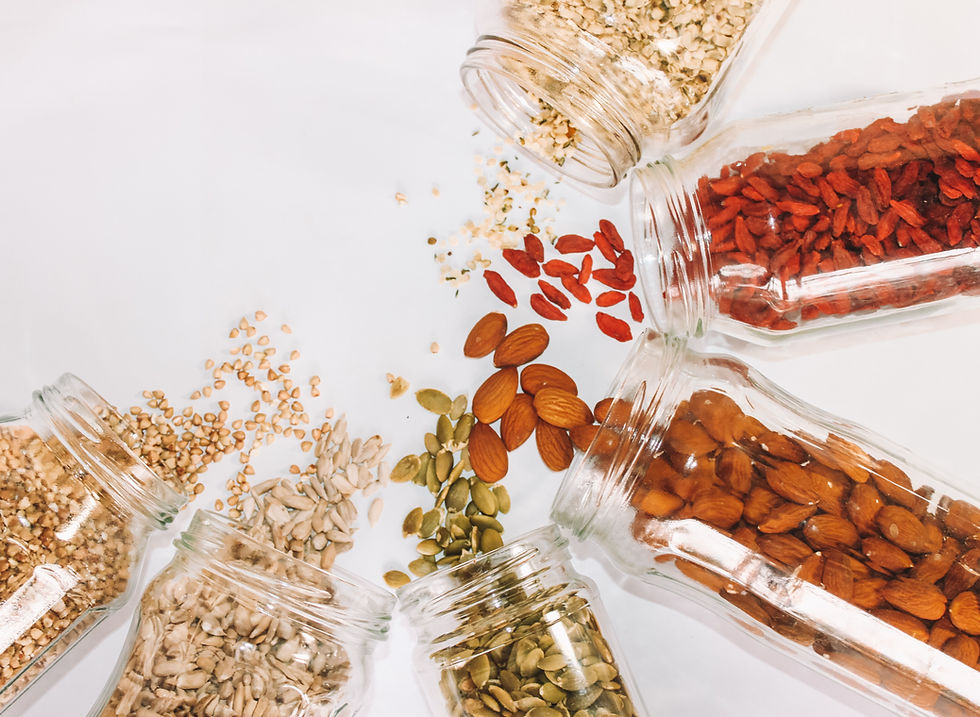Staples to Have in Your Kitchen
- Michelle Slowey, MA,RDN

- Apr 8
- 2 min read
by Michelle Slowey, RDN

Eating a less processed diet starts with stocking your kitchen with nutritious, whole-food staples. These essentials can help you create flavorful meals while boosting your intake of fiber, protein, and healthy fats.
Nuts & Seeds: A Crunchy, Nutrient-Packed Addition
Nuts and seeds add a satisfying crunch to yogurt, salads, and baked goods while providing essential nutrients. They are a great source of fiber—helping you reach the recommended 25-30 grams per day—and heart-healthy omega-3 fatty acids. Nuts can be roasted, sautéed with vegetables, or blended into nut butter for a protein-rich spread.
Cacao nibs, with their rich chocolate flavor, can be sprinkled on oatmeal or smoothies, and certain brands even contain high amounts of fiber.

Great options to stock:
Walnuts
Cashews
Pumpkin seeds
Almond or natural peanut butter
Chia seeds
Cacao nibs
Ground flaxseed
Fresh Produce for Flavor & Versatility
Fresh fruits and vegetables enhance the taste of your meals while providing essential vitamins, minerals, and antioxidants.

Avocados: Add to salads, eggs, smoothies, and sandwiches, or puree into a creamy salad dressing.
Garlic: Use raw or cooked for bold flavor. Roasting whole garlic creates a caramelized, sweet spread for vegetables and bread.
Lemons: Squeeze the juice into soups, salads, fruit, and smoothies for a fresh burst of flavor.
Berries: Low-glycemic and perfect for yogurt, cottage cheese, or as a natural alternative to jelly in a PB&J sandwich.
Bananas: A natural sweetener for baked goods—use in banana bread, pancakes, oatmeal, or even ice cream when frozen.
Spinach: A versatile green that blends easily into smoothies, salads, soups, and omelets.
Dried fruit: A small amount provides more fiber than fresh fruit. Try blending dates into a caramel-like sauce for a natural sweetener.
Protein: A Key Ingredient for Balanced Meals
Adding a source of lean protein to every meal helps with satiety and muscle maintenance.
Greek or Skyr yogurt: Use to make homemade bagels, muffins, dips, and sauces.
Low-fat cottage cheese: Whisk into eggs for a high-protein omelet.
Protein powder: Choose one with 20-25 grams of protein per serving and mix into smoothies, pancake batter, or hot cereal.
Eggs: A versatile protein for any meal.
Chickpeas: Great for salads, roasting, hummus, or even in healthy desserts.
Chicken or ground turkey: Lean, adaptable proteins perfect for meatballs, burgers, chili, or meatloaf.
Broth: A great low-fat alternative to cook foods while enhancing flavor.

Whole Grains & Flours for Healthy Baking
Many healthy recipes require alternative flours or whole grains. Oats, for example, can be blended in a food processor to create oat flour.
Whole wheat flour
Rolled oats
Almond flour
Healthy Oils, Sweeteners & Seasonings
Using the right oils and natural sweeteners can enhance your meals while reducing processed ingredients. Seasonings are essential for adding depth of flavor to meals—keep a variety on hand.
Olive oil: Ideal for drizzling on vegetables and salads or lightly sautéing foods.
Avocado oil: Best for high-heat cooking.
Balsamic vinegar: A great base for marinades and dressings.
Pure maple syrup & honey: Natural alternatives to processed sugar, perfect for coffee or baking.

Michelle Slowey, RDN




Comments